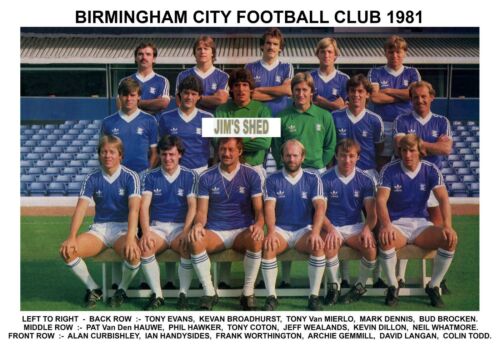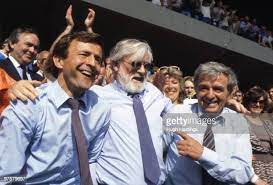7. Mar, 2022
CHELSEA'S UNLIKELY SAVIOURS
Chelsea Football Club are never far from the headlines, in the past 2 weeks the Blues have lost the League Cup Final and appear to be on the cusp of losing owner Roman Abramovich. All things need to be put into perspective, the wind of uncertainty blowing through Stamford Bridge is a mere breeze compared to the horrors faced by the people of Ukraine
More seasoned visitors to The Shed will also be able to put current events in their proper footballing context, the Bridge has had to withstand choppier waters then this. In 1981 John Neal was appointed Chelsea manager, the swinging Kings Road of Michael Caine, Twiggy, Peter Osgood and Charlie Cooke was now a very distant memory. The hallowed turf that once the manor of Ossie, Charlie and Ron 'Chopper' Harris -was now been visited by the less celebrated talents of Grimsby Town and Shrewsbury Town. In short Chelsea were a poor Second Division club.
In stark contrast to its affluent surrounding area Chelsea were on their uppers, the building of the East Stand had put the Blues £3 Million in the red. But at least glamour remained in the dug out. Tottenham Hotspur's double winning captain Danny Blanchflower had a brief stint as Chelsea manager. When the West End outfit were relegated to the second tier in 1979, Blanchflower was sacked and replaced by his assistant, one Geoff Hurst. In those days England's 1966 World Cup winning legend was plain old Geoff, the knighthood arrived in1998. Despite been the only man to score a hat trick in a World Cup Final Hurst was unable to gain promotion to the top flight. However, their were bright spots, not least the emergence of young players. Midfielder Ray Wilkins and striker Clive Walker were the cream of the crop. Wilkins made history when he captained the Blues at the tender age of 17, the youngest man ever to lead a Chelsea side out. He went on to become an England player. But the combination of prolonged Second Division football and crippling debts gave the board no choice. The clubs prized asset was sold to Manchester United in 1981
Unlike his two immediate predecessors John Neal had a less glamorous road to the Bridge. A dependable Full Back at Aston Villa, Neal had tasted League Cup glory in 1962. In 1968 the softly spoken Geordie became manager of Fourth Division Wrexham leading the Welsh club to promotion in 1970. Four years later the Red Dragons reached the FA Cup Quarter Finals. In 1977 Neal returned to the North East, succeeding Jack Charlton as Middlesbrough manager. Neal did a steady job at Boro before becoming frustrated at the lack of investment at Ayresome Park.
His arrival in West London was greeted by dismay in The Shed End. Banners were unfold expressing the fans' opposition to Neal's appointment. A generation of fans raised on the FA Cup triumph of 1970 and winning the European Cup Winners Cup the following year were unconvinced. A shock FA Cup win over Liverpool helped ease the pressure. Goals from Walker and Colin Lee sent the reigning European Champions packing. The victory was the highlight of a run to the 1982 FA Cup Quarter Finals.
The same year saw Ken Bates become Chelsea chairman. Bates made his fortune in haulage before becoming chairman of Oldham Athletic in the 1960s. After a short stint as Wigan Athletic vice chairman, Ealing born Bates returned to his roots when he famously brought the Blues for the princely sum of £1. The new chairman had a hefty in-tray, for a start Chelsea did not actually own their home ground. Property developers Merrrier Estates owned the Stamford Bridge freehold. Bates embarked on a lengthy but ultimately successful battle to secure ownership of The Bridge. The matter was finally resolved when Merrier were declared bankrupt
Free from paying rent to an unwanted landlord, the new regime turned their attention to matters on the pitch. The 82 cup run papered over the cracks, in the Spring of 1983 Chelsea were facing the prospect of Third Division football for the first time in their history. Almost 30 years since the Blues had been Champions of England. The Blues survived thanks to Clive Walker's winner at Grimsby. It seemed inevitable that John Neal would be shown the door, but Ken Bates was always his own man. Instead of sacking Neal, the manager was handed a healthy transfer budget.
A raft of new faces arrived, goalkeeper Eddie Niedzwiecki, winger Pat Nevin and strikers Kerry Dixon and David Speedie all joined the Stamford Bridge revolution. In recent times Chelsea have become synonymous with big money signings but few will have matched the positive effect of Neal's acquisitions. They transformed Chelsea from strugglers to Second Division Champions within 12 months. The attacking trio of Dixon, Speedie and Nevin caused havoc for opposing defences. Between them they scored almost 200 goals in just three seasons. Dixon went on to become a true Blues legend scoring 193 goals in 9 years. Indeed only Frank Lampard (211) and Bobby Tambling (202) have scored more goals for Chelsea.
Unlike many promoted teams, Neal's men prospered on their return to the First Division. They finished 6th and reached the League Cup Semi Final. That run included an amazing 4-4 draw at Sheffield Wednesday. The Blues trailed 3-0 at half time but mounted a memorable comeback, at one stage they led 4-3 before a late Wednesday equaliser. Chelsea won the replay but lost to Sunderland in a two legged Semi Final. Ironically Clive Walker scored two of the Wearsiders goals.
Ill health forced Neal to step down in 1985 and Blues legend John Hollins was appointed manager. Hollins(pictured left in cover photo with Ken Bates centre and John Neal right) had been a fine midfielder in the early 70s side and made a bright start to life in the hot seat. Chelsea again finished 6th and won the Full Members Cup, a tournament introduced following the expulsion of English clubs from European competition, Hollins' side beat Manchester City 5-4 at Wembley. Speedie was the hero with a historic hat trick, the Scot became the first player since Geoff Hurst to score a hat trick at the home of English football. But Hollins dream start rapidly turned into a nightmare, he was sacked as the Blues headed for relegation. Bobby Campbell took over but couldn't prevent the drop. Their fate was sealed when Middlesbrough beat them in a two legged play off final. Campbell was to become another unsung hero. Like John Neal he led Chelsea to an instant return to the top flight, winning the Second Division title in 1989
The Sunderland and Middlesbrough defeats were both marred by crowd trouble. Ken Bates had seen enough, his solution was to install an 11 foot fence around the terracing, the fence would be topped off with barbed wire and electric bars. Many felt the electric deterrent was a step too far. Sports Minister Neil McFarlane felt Bates had overstepped his mark, the Chelsea chairman's response was typically robust saying "at least we are trying to do something" and telling McFarlane to "get stuffed" The controversial scheme was finally scuppered when the Greater London Council refused planning permission.
The electric fence saga typified the Ken Bates era. His white beard gave him a Santa Claus appearance, but chairman Ken was more combative than cuddly. Former England striker Clive Allen had a brief spell at Chelsea in the early 90s. In his autobiography Allen describes how Bates came to blows with his own captain, Before home games Bates would pay a visit to the Blues dressing room. As the team prepared to face Manchester United the Chelsea chairman made his entrance wearing a fur coat. As Bates began his address Dennis Wise intervened,, as Clive Allen describes "What the f... hell have you got on, he said I had to remind myself this was the club captain talking to the chairman."
Bates replied by calling Wise a little s...., the two men then squared off with Wise throwing Ken Bates on to the floor. Allen then asked if the fight should be broken up, to which Kerry Dixon replied "Oh No, every time he comes into the dressing room they have a wrestle or a fight."
I doubt anyone was taking on Sir Alex Ferguson across the corridor, although Chairman Ken might have had a pop. But for all his eccentric behavior Bates saved Chelsea in their darkest hour. His partnerships with John Neal and Bobby Campbell laid the foundations for the all conquering Blues of today

